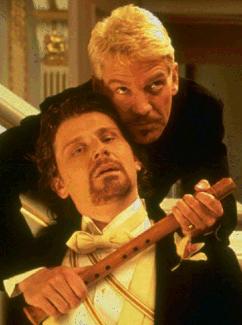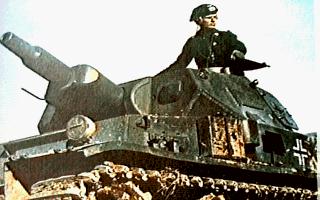|
|
It is a well-known fact that people have been unpleasant as long as history can remember. What people don't realise is the amount of progress that has been made in this particular scientific field in recent years.
In the stone age people were rarely unpleasant. It is widely believed by a bunch of people who want to be proper scientists that this is because they had not yet evolved enough to include "unpleasant" nodes in their tiny brains. Pictures of stone age men (and women, for that matter) hardly ever show them being unpleasant to each other, as one historian didn't tell me.
"We've not once found a picture of stone age man being really unpleasant," he didn't say, "although we've occasionally found pictures of men dragging women about by the hair [Fig. 1]. In our usual historian way we've decided to guess wildly that this could be a show of early unpleasantness, but then again, what would we know, eh?"
 |
Fig. 1 - Is this an attempt at pre-historic unpleasantness? I don't know, and neither do the experts, to be honest. |
One thing that is known, however, is that dinosaurs had humans beaten hands-down as far as unpleasantness goes, having mastered it from an early age. This is shown in Fig. 2, which is an actual reproduction of a photograph taken by Dr I.P. Freely. This clearly shows that dinosaurs were unpleasant - especially to humans, who they regarded as being "a bit soft".
"Personally I can't stand the wimpy gits," said one dinosaur (name withheld) that I interviewed, "all they do is ponce about all day, picking berries and stuff. Utter rubbish. They should be getting into fights, like we do."
"Not that I blame them," he continued, "after all, they're a bit badly designed, aren't they? No horns, or claws, or big sharp teeth. All they can do is thump each other a bit, which doesn't exactly make for exciting viewing. Not like us lot, all ripping and tearing and gouging at each other. There was this one time, right..." He went on further, but by now I'd gotten bored, and switched off the tape recorder.
It is worth noting, however, that the dinosaurs all died out shortly after this interview, which proves that just because you're unpleasant it doesn't mean that you're clever as well.
 |
|
|
Historians noticed the first peak in human unpleasantness during medieval times - when it was commonplace for evil kings to rule their lands with regimes of terror, and such-like. It was around this time that humans managed to exceed the unpleasantness of the dinosaurs' descendants (the dragons). This was largely due to the fact that dragons were a bit too nice, and often preferred hoarding vast piles of gold to the more traditional eating villagers alive, and torching towns with their firey breath. This left them with a firm disadvantage when particularly unpleasant knights turned up, and started to slaughter them left, right, and centre. Once these knights had run out of dragons to butcher they turned upon the peasants, and a great deal of blood-letting ensued. Truely this was the time of much unpleasantness, and as such peasants were often revolting. (Clever wording, I know.)
 |
Fig. 3 - In medieval times knights turned the tables of unpleasantness and started to do nasty things to dragons (who were primarily interested in reading books rather than eating people). |
|
|
For reasons unknown the level of unpleasantness dropped suddenly during the following centuries, and there has been much speculation over why this might be. Unfortunately I can't actually remember any of it, but rest assured that it's out there - and there's alot of it. Oh yes.
The Victorian age left people in no doubt that unpleasantness was definitely not "in", and that it was far more classy to be able to beat your opponent down with your rapier wit and intellect. However, all was not well in the psyche of the people. Reading through many of the books and plays written in the era it is clear that there was a deep desire for unpleasantness among the populace, as they contain scenes of violence, grave-robbing, incest, and (perhaps worst of all) romance. Bill Obviouslymadeupname (an expert in this field) recently told me:
"Hmm? What? Is this thing on? Okay ... ahem. Well, yes, it's clear that the people's restraint led to a deep desire for unpleasantness, the like of which had never been seen before - although in this case it was literary unpleasantness. As a comparison: If Shakespeare was alive today and wrote stuff like Hamlet or Macbeth he'd be hunted down in the streets and lynched. Probably."
"What? Are you still here? Piss off, before I call the police ...."
 |
Fig. 4 - "Listen, mate, I've warned you before about eying-up
my girlfriend. Do it again and I'll smash your face in, okay?"
[Hamlet image (c) Castle Rock Entertainment 1996] |
|
|
After the Victorians died unpleasantness was, once again, free to become cool. This was noticed by several nations who decided to take part in that high-point of unpleasantness - the world war. There have been two of these monumental spectator events, world war one and world war two - named for ease of use and to make it a bit more obvious which one came first.
So anyway, both sides lined up their troops, dug their trenches, and settled in for what promised to be a right good pagga. It was only after kick-off that it was noticed that not a great deal of exciting stuff was going on. The most fun to be had was having a sweepstake on who's troops would get hit by their own artillary. It became obvious that something new needed to be invented: The tank.
This marvel of modern technology was welcomed by both sides, as the interest they generated helped to boost steadily decreasing television ratings. The tank captured the public's imagination, and quickly became the star player of any team that decided to use one. This was due to several things:
- They had guns. Lots of them.
- They had armour. Lots of it.
- They could kill people. Lots of them.
This was the high-point of mechanical unpleasantness for some time, and crews were often finding new ways to be unpleasant from within a tank. One particular English gent (William "Jolly Good Chap" Hodgeson) is noted in this field as having invented no less than fifty ways to be nasty to people when you're cowering inside a diesel-powered killing machine, the high points of which include such gems as driving through people's front rooms, launching family pets from the main cannon, and the all-time favourite of readers of Tanks Monthly magazine - running over fleeing civilians.
 |
Fig. 5 - "I am hard, because I have a tank." |
And that, my friends, brings us up to the present day. Unpleasantness still reigns supreme, and by following the other links from TIGU you will learn some (but not all) of its many faces. Prepare to be amazed. (Or shocked at the very least.)


|
Maintained by Tony Gowland
Last updated: 11/5/98 |
|---|